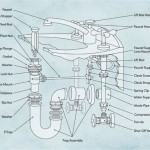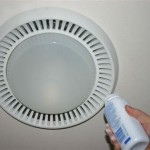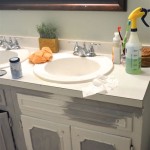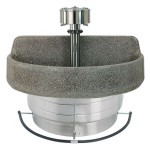How to Replace a Bathroom Tub Spout
Replacing a bathroom tub spout is a common plumbing task that homeowners can often accomplish without professional assistance. Understanding the different types of spouts and the appropriate removal and installation techniques are crucial for a successful outcome. This article provides a comprehensive guide to replacing a bathroom tub spout, covering the necessary tools, preparation steps, and detailed instructions for various spout types.
Before commencing the replacement process, it is important to identify the type of tub spout currently installed. Tub spouts generally fall into two main categories: slip-on spouts and threaded spouts. Slip-on spouts are secured to a copper pipe using a set screw, while threaded spouts screw directly onto a threaded pipe. The identification of the spout type is paramount as it dictates the removal and installation method.
Identifying the Tub Spout Type
The first step in identifying the tub spout type is to visually inspect the base of the spout where it meets the wall. If a small screw is visible, usually located on the underside of the spout, it is highly likely a slip-on spout. This screw, known as a set screw, tightens against the copper pipe to hold the spout in place. Threaded spouts, on the other hand, will not have a visible set screw. Instead, the spout will appear to be directly connected to the pipe coming out of the wall.
If a visual inspection is inconclusive, a gentle attempt to rotate the spout can provide further clues. If the spout rotates freely, it is likely a threaded spout. However, if it feels firmly attached, even after loosening the set screw (if present), further investigation might be required. In some cases, mineral buildup or corrosion can make it difficult to discern the spout type. Careful examination and patience are essential to avoid damaging the plumbing.
In situations where the spout is heavily corroded or painted over, removing any visible obstructions can help in identifying the attachment method. Using a utility knife to carefully score around the base of the spout can remove paint or caulk that may be obscuring the set screw or the threads. If doubt persists, consulting with a plumbing professional is recommended to prevent potential damage to the plumbing system.
Once the spout type is identified, gathering the necessary tools and materials is the next crucial step. The required tools will vary depending on the spout type and the specific installation requirements. However, a basic toolkit should include the following items:
*Adjustable wrench
*Screwdriver (Phillips head and flat head)
*Penetrating oil (e.g., WD-40)
*Plumber's tape (Teflon tape)
*Rag or towel
*Utility knife
*Pliers (optional)
*New tub spout (compatible with the identified type)
In addition to these tools, depending on the specific situation, additional supplies may be necessary. For example, if the copper pipe is corroded or damaged, it may need to be cleaned or replaced. Similarly, if the existing spout was heavily caulked, a caulk remover tool and new caulk may be required for a clean and watertight installation.
Removing a Slip-On Tub Spout
Removing a slip-on tub spout is generally a straightforward process. The first step is to locate the set screw on the underside of the spout. Using a screwdriver of the appropriate size, carefully loosen the set screw. It is crucial to avoid completely removing the set screw, as it can be difficult to reinstall. Loosening it sufficiently to allow the spout to slide off is adequate.
Once the set screw is loosened, gently pull the spout straight away from the wall. If the spout is stuck due to mineral buildup or corrosion, applying penetrating oil around the base of the spout can help to loosen it. Allow the penetrating oil to soak in for several minutes before attempting to remove the spout again. Gentle twisting motions, in addition to pulling, can also aid in dislodging the spout.
If the spout remains difficult to remove, a rubber mallet can be used to gently tap the spout near the base. Avoid using excessive force, as this can damage the copper pipe or the surrounding wall. If all else fails, a pipe wrench can be used to grip the spout, but care must be taken to protect the spout's finish with a rag or towel to prevent scratches. Once the spout is removed, inspect the copper pipe for any damage or corrosion. If the pipe is damaged, it may need to be repaired or replaced before installing the new spout.
Removing a Threaded Tub Spout
Removing a threaded tub spout requires a slightly different approach. Since the spout is screwed directly onto a threaded pipe, it needs to be unscrewed to be removed. Begin by gripping the spout firmly with an adjustable wrench. Protect the spout's finish with a rag or towel to prevent scratches from the wrench. Applying penetrating oil around the base of the spout where it meets the wall can help to loosen any corrosion or mineral buildup.
Carefully turn the spout counterclockwise. It may require some force to break the initial seal. If the spout is particularly stubborn, apply more penetrating oil and allow it to soak in for a longer period. Continue turning the spout counterclockwise until it is completely unscrewed from the pipe. Be prepared for a small amount of water to leak out once the spout is fully removed. Have a rag or towel ready to absorb any escaping water.
After removing the old spout, inspect the threaded pipe extending from the wall. Remove any old plumber's tape or sealant from the threads. If the threads are damaged or corroded, a wire brush can be used to clean them. In severe cases, the threaded pipe may need to be replaced by a plumbing professional. Before installing the new spout, ensure that the pipe is clean and in good condition to ensure a watertight seal.
With the old spout removed and the pipe prepared, the installation of the new spout can begin. The installation process will vary slightly depending on the type of spout being installed, but the general principles remain the same.
For slip-on spouts, ensure the copper pipe is clean and free of any burrs or sharp edges. Apply a thin layer of plumber's grease to the outside of the pipe to facilitate smooth installation. Slide the new spout onto the pipe until it reaches the wall. Align the spout so that the set screw is facing downward. Tighten the set screw securely, but avoid over-tightening, as this can damage the pipe. Once the set screw is tightened, ensure that the spout is firmly attached and does not wobble.
For threaded spouts, begin by wrapping the threaded pipe with several layers of plumber's tape. Wrap the tape clockwise, ensuring that it covers all of the threads. This will help to create a watertight seal. Carefully screw the new spout onto the threaded pipe, turning it clockwise. Tighten the spout until it is snug against the wall. Avoid over-tightening, as this can damage the pipe or the spout. Once the spout is tightened, ensure that it is properly aligned and does not leak. If necessary, adjust the spout's position slightly to achieve a tight seal.
After installing the new spout, test it thoroughly for leaks. Turn on the water and allow it to flow through the spout for several minutes. Inspect the base of the spout where it meets the wall for any signs of water leakage. If a leak is detected, tighten the set screw (for slip-on spouts) or the spout itself (for threaded spouts) slightly. If the leak persists, remove the spout and inspect the pipe and the spout for any defects. Reapply plumber's tape or sealant as needed and reinstall the spout. If the leak continues despite these efforts, consulting with a plumbing professional is recommended.
Finally, apply a bead of caulk around the base of the spout where it meets the wall. This will help to create a watertight seal and prevent water from seeping behind the wall. Choose a caulk that is specifically designed for bathroom applications and is mold and mildew resistant. Apply the caulk evenly and smoothly, and wipe away any excess with a damp cloth. Allow the caulk to dry completely according to the manufacturer's instructions before using the tub or shower.

Learn How To Remove And Install Various Tub Spouts

How To Replace A Bathtub Spout Diy Family Handyman

Learn How To Remove And Install Various Tub Spouts

How To Replace A Tub Spout Project Tutorial Bob Vila

Replacing A Tub Spout An Easy Repair Job Theworldlink Com

How To Replace A Tub Spout

Learn How To Remove And Install Various Tub Spouts

How To Replace A Tub Spout Project Tutorial Bob Vila

How To Fix A Leaking Bathtub Faucet Diy Family Handyman

3 Ways To Remove A Tub Faucet Wikihow
Related Posts







